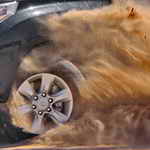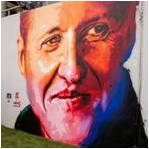Espero no les moleste que esté en inglés, habla de la diferencia de Red Bull vs Ferrari Como equipo para Vettel.
news.com.au
Sport
Motorsport
F1 expert Mark Hughes: Ferrari to blame for Vettel chaos
SEPTEMBER 6, 2018 8:33AM
Vettel taken Vettel taken out by Hamilton on lap 1out on lap 1
Mark Hughesnews.com.au
Sebastian Vettel’s first-lap incident with Lewis Hamilton at Monza is just the latest in a litany of errors and misjudgements from the multiple world champion in the last couple of seasons.
This year alone he has lost crucial points in Baku (locking up trying to take the lead and finishing fourth instead), France (locking up and sliding into Valtteri Bottas on lap one), Austria (blocking Carlos Sainz in qualifying and receiving a grid penalty that cost him any chance of victory) and Germany (sliding off into the barriers while leading).
That’s a loss of 63 points — in addition to the extra points Hamilton has scored as a result of Vettel’s mishaps. So he’s currently 30 points behind when he could be more than that in front.
It follows a similar pattern to last year (Baku, Singapore, Mexico).
So it’s all Vettel’s fault?
Actually, no. No, it’s not. It is also Ferrari’s fault.
In fact, the root of the pressure that is behind these accidents almost certainly originates from the operational shortfalls of the team. Prior to his joining the Scuderia, Vettel’s career was almost blemish-free. Pressure errors were not part of his game.
Which implies that there is something about driving for Ferrari which is triggering them.
Listening to his radio messages during his Ferrari years reveals a lot.
Whether it was his outburst amid the chaos of a sudden downpour in Spa qualifying — “Lift the car up for ***’s sake, you’ll crush the floor,” — or his frequent questioning of strategy, it is clear he feels the need to oversee the operation of his car.
At the more smoothly-drilled Red Bull team, usually all he had to do was drive. Much as Hamilton does now at Mercedes. At Ferrari, Vettel finds himself trying to manage the team from the cockpit — clearly because he feels he needs to.
Much as Ferrari have been perhaps the most technically-creative team of all in the last couple of seasons (for the first time in a decade), it is still operationally a shaky one on a race weekend. So Vettel is driving the best car being run by less than the best team.
With his mind thus split between roles, amid the constant concern about whether everything has been thought through in a fast, ever-moving environment, he’s feeling the pressure in a way he wasn’t at his previous teams.
That’s quite aside from the pressure of representing Ferrari as the lead driver when it has given him a potentially title-winning car. That was the case last year and it’s even more so this season.
Excessive pressure — especially over issues outside of your direct control — is especially stressful and it seems entirely logical that this should be linked with a pattern of errors and wrong split-second decisions.
Perhaps he has tried to model his move to Ferrari upon his mentor’s, Michael Schumacher, who was the nucleus of a very tightly-knit team that was focused around him.
But what Schumacher had in his favour was Ross Brawn running the team with a calm authority, Jean Todt keeping the senior managerial pressures away from the race team and Nigel Stepney as chief mechanic drilling the team like an army sergeant. Under those circumstances, Vettel could cease to worry about strategy calls, pit-lane operations or whether the right tyres were being fitted and could just relax into extracting the maximum from his driving skills. Much as Hamilton can.
Monza was yet another case study of the tension between Vettel and the team — and how it impacted upon the entire weekend.
It was Raikkonen’s turn this weekend to be second car out in the qualifying runs — and therefore to get the tow from the sister car (at a track where that’s worth significant lap time).
Firstly, with their lead driver chasing the title, perhaps the team should have overridden that agreement. Secondly, even respecting that agreement, the team fell down in trying to mitigate against it.
The plan was to get Vettel’s car turned around for the final Q3 run fast enough that they could just respond to when the Mercedes went out, and position Vettel directly to their tail as they left the garages — so as to get the slipstream from them instead.
But it wasn’t turned around quite quickly enough. Sainz’s Renault got between them — and by the time Vettel had found a way around that on the out-lap, Hamilton was out of towing reach.
Perhaps irritated by all this, he drove what was by his own admission a very messy lap that fell short of the pole time he’d help tow Raikkonen to by just over a tenth of a second. Had he started on pole, he’d probably have not found himself in the position he was in on the opening lap that triggered his collision with Hamilton.
In fact, it’s entirely conceivable he could’ve won the race as Raikkonen engaged Hamilton in battle.
Upon being told his qualifying position, his words spoke volumes: “We’ll speak later.”
This article was originally published by Sky Sports and reproduced with permission.
https://www.news.com.au/sport/motorspor ... f951e5e75e
Artículo en Inglés sobre Vettel y Ferrari
17 mensajes
• Página 1 de 2 • 1, 2
Re: Artículo en Inglés sobre Vettel y Ferrari
Viene a decir que la culpa de los errores de Vettel no son de Vettel, son de Ferrari porque Seb se tiene que ocupar de todo el equipo, estrategias, puesta a punto...
En fin.
Saludos
En fin.
Saludos
Sólo hay una forma razonable de ser segundo con un Ferrari: que el otro Ferrari haya ganado


-

Hudson - Mensajes: 2687
- Registrado: 20 Abril 2010, 17:46
Re: Artículo en Inglés sobre Vettel y Ferrari
El problema no es que el artículo esté en inglés sino que es de un medio inglés. Como tal no solo tiene los tintes amarillistas típicos de los medios (des)informativos de ese país sino que estos se ven incrementados cuando se trata del "archirrival" Ferrari (¿Cómo puede ser algo italiano superior a lo inglés?) y más aún combinado con un piloto alemán (Aquí es aún más evidente la inferioridad inglesa -no reconocida- frente a lo alemán en innumerables campos).
Personalmente leo medios ingleses un poco como entretenimiento y otro poco para saber si lo que leo en español es confiable o si viene de estas fuentes amarillistas.
Personalmente leo medios ingleses un poco como entretenimiento y otro poco para saber si lo que leo en español es confiable o si viene de estas fuentes amarillistas.
-

elmusiloco - Mensajes: 1868
- Registrado: 19 Abril 2012, 20:24
- Ubicación: Valencia
Re: Artículo en Inglés sobre Vettel y Ferrari
dasalcedo , es necesario poner la url de la fuente, para evitar problemas de copy 

-

GTO - Mensajes: 35492
- Registrado: 01 Enero 2007, 23:56
- Ubicación: al sur del sur, frente al mare nostrum
Re: Artículo en Inglés sobre Vettel y Ferrari
Este es en español 
Vettel aún puede evitar la retirada de Alonso de la Fórmula 1
A día de hoy creo que solo una persona puede evitar la anunciada retirada de Fernando Alonso de la Fórmula 1 a final de temporada. Y esa persona es Sebastian Vettel.
Las nefastas actuaciones del piloto alemán al volante del mejor Ferrari de la última década han irritado a los incondicionales de la escudería italiana, unos tifosi que ven cada vez más alarmados cómo el título mundial puede escaparse de sus manos.
Ya os hablé a principios de agosto de los cuatro errores fundamentales de Vettel en este campeonato, pero a ellos habría que sumar el más gordo, el que cometió en el pasado GP de Italia al tocarse con Hamilton de forma incomprensible, un error que arruinó su carrera en un escenario emblemático para los tifosi como es Monza.
La presión es cada vez mayor para la dirección de Maranello, una factoría que llevaba años luchando por tener un monoplaza competitivo y que cuando por fin lo ha conseguido se encuentra con un piloto que no está siendo capaz de aprovecharlo.
Evidentemente, hay una gran obstáculo que bloquearía un hipotético regreso de Alonso a Ferrari y es Mauricio Arrivabene. El actual director deportivo del equipo italiano no congenia demasiado con Fernando, han tenido algún que otro desencuentro en el pasado, y parece que preferiría sacrificar el título a tener que tragarse su orgullo para recurrir al bicampeón español.
No obstante, la afición de Ferrari es un factor muy importante en Maranello, quizás más que en ningún otro equipo, y su cada vez mayor descontento con Vettel podría desencadenar algún movimiento inesperado. Empezando por la cabeza de Arrivabene.
PD. Nadie tiene dudas este año de que el talón de Aquiles de Ferrari está en sus pilotos.
https://blogs.20minutos.es/formula-1...-la-formula-1/

Ganar es todo. Si terminas segundo, sólo lo recuerdan tu mujer y el perro
-

meteoro - Advertido

- Mensajes: 13945
- Registrado: 18 Septiembre 2007, 18:54
Re: Artículo en Inglés sobre Vettel y Ferrari
Tiene guasa el tema 
El día que ha probado el indycar.
En los últimos 4 años sus pobres resultados han hecho que se le vincule a Ferrari día sí y día también (que si se equivocó al irse o no, que si volverá o no...) y así será incluso después de su retirada.
Es mejor asumir que se va de la F1 y que su tiempo en Ferrari ya pasó
El día que ha probado el indycar.
En los últimos 4 años sus pobres resultados han hecho que se le vincule a Ferrari día sí y día también (que si se equivocó al irse o no, que si volverá o no...) y así será incluso después de su retirada.
Es mejor asumir que se va de la F1 y que su tiempo en Ferrari ya pasó
-

Trupon - Mensajes: 16439
- Registrado: 24 Diciembre 2010, 03:57
- Ubicación: Guipúzcoa
Re: Artículo en Inglés sobre Vettel y Ferrari
GTO escribió:dasalcedo , es necesario poner la url de la fuente, para evitar problemas de copy
Acá va
https://www.news.com.au/sport/motorspor ... f951e5e75e
- dasalcedo
- Mensajes: 9
- Registrado: 07 Octubre 2013, 02:33
Re: Artículo en Inglés sobre Vettel y Ferrari
meteoro escribió:Este es en español Vettel aún puede evitar la retirada de Alonso de la Fórmula 1
Vettel aún puede evitar la retirada de Alonso de la Fórmula 1
A día de hoy creo que solo una persona puede evitar la anunciada retirada de Fernando Alonso de la Fórmula 1 a final de temporada. Y esa persona es Sebastian Vettel.
Las nefastas actuaciones del piloto alemán al volante del mejor Ferrari de la última década han irritado a los incondicionales de la escudería italiana, unos tifosi que ven cada vez más alarmados cómo el título mundial puede escaparse de sus manos.
Ya os hablé a principios de agosto de los cuatro errores fundamentales de Vettel en este campeonato, pero a ellos habría que sumar el más gordo, el que cometió en el pasado GP de Italia al tocarse con Hamilton de forma incomprensible, un error que arruinó su carrera en un escenario emblemático para los tifosi como es Monza.
La presión es cada vez mayor para la dirección de Maranello, una factoría que llevaba años luchando por tener un monoplaza competitivo y que cuando por fin lo ha conseguido se encuentra con un piloto que no está siendo capaz de aprovecharlo.
Evidentemente, hay una gran obstáculo que bloquearía un hipotético regreso de Alonso a Ferrari y es Mauricio Arrivabene. El actual director deportivo del equipo italiano no congenia demasiado con Fernando, han tenido algún que otro desencuentro en el pasado, y parece que preferiría sacrificar el título a tener que tragarse su orgullo para recurrir al bicampeón español.
No obstante, la afición de Ferrari es un factor muy importante en Maranello, quizás más que en ningún otro equipo, y su cada vez mayor descontento con Vettel podría desencadenar algún movimiento inesperado. Empezando por la cabeza de Arrivabene.
PD. Nadie tiene dudas este año de que el talón de Aquiles de Ferrari está en sus pilotos.
https://blogs.20minutos.es/formula-1...-la-formula-1/
Esto es lo que ya había dicho yo y me llamaron Alonsista por decirlo
Pero no creo ni que Ferrari llame a Alonso ahora... y mucho menos que ahora Alonso quiera volver a Ferrari...
Räikkönen: "He estado ahorrando gasolina. Eso no tiene nada que ver con las carreras"
-

KoKiNa - Mensajes: 1838
- Registrado: 24 Septiembre 2010, 01:43
Re: Artículo en Inglés sobre Vettel y Ferrari
A, que no eres alonsista?? Será que no nos damos suficiente amor 
Me hizo tanta gracia cuando lo vi que no me pude resistir a traerlo

Me hizo tanta gracia cuando lo vi que no me pude resistir a traerlo

Ganar es todo. Si terminas segundo, sólo lo recuerdan tu mujer y el perro
-

meteoro - Advertido

- Mensajes: 13945
- Registrado: 18 Septiembre 2007, 18:54
Re: Artículo en Inglés sobre Vettel y Ferrari
KoKiNa escribió:meteoro escribió:Este es en español
Esto es lo que ya había dicho yo y me llamaron Alonsista por decirlo
Pero no creo ni que Ferrari llame a Alonso ahora... y mucho menos que ahora Alonso quiera volver a Ferrari...
Te llamaron Alonsista eh
Firmado, un ferrarista.
-

Trupon - Mensajes: 16439
- Registrado: 24 Diciembre 2010, 03:57
- Ubicación: Guipúzcoa
Re: Artículo en Inglés sobre Vettel y Ferrari
Dejando al margen lo del tema Alonso que no tiene ni pies ni cabeza y que ya son ganas de marear la perdiz, lo que realmente me parece lamentable es como una parte de la prensa, o del entorno de Ferrari se está lanzando ya a la yugular de Sebastian Vettel, menospreciando en absoluto los 4 años de trabajo que lleva realizando en la Scuderia, tildando de fracaso y tirando porquería encima de uno de los mejores pilotos de la actualidad. Es cierto que ha cometido errores puntuales, todos, y lo subrayo... todos los pilotos cometen errores, Hamilton, Alonso, Schumacher, Senna, Prost, etc.... todos han cometido errores, pero sus capacidades compensaban con creces los posibles fallos puntuales que todo ser humano puede cometer. Lo que es muy lamentable es como en la casa roja se olvidan tan pronto de las buenas actuaciones, de las carreras perfectas y las lecciones magistrales para tirar a los pies de los caballos al piloto de turno que por las circunstancias que sea ha cometido un error. Luego es la propia scuderia la que por decisiones absurdas renuncia a pelear los campeonatos de constructores o apoyar a su piloto top manteniendo a pilotos mediocres o en el declive de su carrera, regalando un buen puñado de puntos a sus rivales, pero eso sí, la culpa de perder mundiales no es nunca de la scuderia, sino de su piloto que no es capaz de estar a la altura de lo que se espera en Maranello.
Personalmente me gusta Ferrari, me encantan sus autos, su leyenda y lo que representa en la F1, pero lo que no me gusta en absoluto es su caracter "italiano" y la soberbia que acostumbran a mostrar. Es lo que yo llamo el "sindrome del Real Madrid", la presión mediática, la obsesión por tener que ser los mejores en todo aún sin merecerlo, los tratos de favor más que demostrados, la obligación de tener que adorar a sus estrellas, etc.... todo eso que al final acaba generando en mucha gente un sentimiento de rechazo básicamente por hartazgo, vamos el clásico tópico del italiano.
Personalmente me gusta Ferrari, me encantan sus autos, su leyenda y lo que representa en la F1, pero lo que no me gusta en absoluto es su caracter "italiano" y la soberbia que acostumbran a mostrar. Es lo que yo llamo el "sindrome del Real Madrid", la presión mediática, la obsesión por tener que ser los mejores en todo aún sin merecerlo, los tratos de favor más que demostrados, la obligación de tener que adorar a sus estrellas, etc.... todo eso que al final acaba generando en mucha gente un sentimiento de rechazo básicamente por hartazgo, vamos el clásico tópico del italiano.
-

tatostrom - Mensajes: 926
- Registrado: 14 Abril 2015, 11:56
- Ubicación: A Coruña
Re: Artículo en Inglés sobre Vettel y Ferrari
meteoro escribió:A, que no eres alonsista?? Será que no nos damos suficiente amor
Me hizo tanta gracia cuando lo vi que no me pude resistir a traerlo
Sí, es para enmarcarlo...
Räikkönen: "He estado ahorrando gasolina. Eso no tiene nada que ver con las carreras"
-

KoKiNa - Mensajes: 1838
- Registrado: 24 Septiembre 2010, 01:43
Re: Artículo en Inglés sobre Vettel y Ferrari
Trupon escribió:KoKiNa escribió:
Esto es lo que ya había dicho yo y me llamaron Alonsista por decirlo
Pero no creo ni que Ferrari llame a Alonso ahora... y mucho menos que ahora Alonso quiera volver a Ferrari...
Te llamaron Alonsista eh


Jolin, hay que ver con la gente...

Firmado, un ferrarista.
Hay gente muy perversa...
Firmado, otro ferrarista
Räikkönen: "He estado ahorrando gasolina. Eso no tiene nada que ver con las carreras"
-

KoKiNa - Mensajes: 1838
- Registrado: 24 Septiembre 2010, 01:43
Re: Artículo en Inglés sobre Vettel y Ferrari
tatostrom escribió:Dejando al margen lo del tema Alonso que no tiene ni pies ni cabeza y que ya son ganas de marear la perdiz, lo que realmente me parece lamentable es como una parte de la prensa, o del entorno de Ferrari se está lanzando ya a la yugular de Sebastian Vettel, menospreciando en absoluto los 4 años de trabajo que lleva realizando en la Scuderia, tildando de fracaso y tirando porquería encima de uno de los mejores pilotos de la actualidad. Es cierto que ha cometido errores puntuales, todos, y lo subrayo... todos los pilotos cometen errores, Hamilton, Alonso, Schumacher, Senna, Prost, etc.... todos han cometido errores, pero sus capacidades compensaban con creces los posibles fallos puntuales que todo ser humano puede cometer. Lo que es muy lamentable es como en la casa roja se olvidan tan pronto de las buenas actuaciones, de las carreras perfectas y las lecciones magistrales para tirar a los pies de los caballos al piloto de turno que por las circunstancias que sea ha cometido un error. Luego es la propia scuderia la que por decisiones absurdas renuncia a pelear los campeonatos de constructores o apoyar a su piloto top manteniendo a pilotos mediocres o en el declive de su carrera, regalando un buen puñado de puntos a sus rivales, pero eso sí, la culpa de perder mundiales no es nunca de la scuderia, sino de su piloto que no es capaz de estar a la altura de lo que se espera en Maranello.
Personalmente me gusta Ferrari, me encantan sus autos, su leyenda y lo que representa en la F1, pero lo que no me gusta en absoluto es su caracter "italiano" y la soberbia que acostumbran a mostrar. Es lo que yo llamo el "sindrome del Real Madrid", la presión mediática, la obsesión por tener que ser los mejores en todo aún sin merecerlo, los tratos de favor más que demostrados, la obligación de tener que adorar a sus estrellas, etc.... todo eso que al final acaba generando en mucha gente un sentimiento de rechazo básicamente por hartazgo, vamos el clásico tópico del italiano.
Los cuatro años de trabajo de Vettel no son para enmarcar precisamente, salvo la temporada 2015. En 2016 tocó fondo, hasta el punto de reconocerlo él, si no recuerdo mal. Tocó fondo como conductor y por comportamiento. Si no recuerdo mal mando a Charlie a tomar por culo. Aquí dejo un error sin consecuencias de 2016 que es significativo de su nivel de concentración: http://www.marca.com/motor/formula1/gp- ... b4625.html. 2017 la tenemos reciente. Ferrari tenía coche para luchar y vimos qué temporada hizo, sobre todo en la recta final. Y en 2018 qué vamos a decir, colección de errores. Ferrari tiene que fichar al mejor y, hoy por hoy, independientemente de opiniones y gustos, con los números en la mano, ese es Lewis.
"Not 100% sure what’s happening. Just push like hell to the end of the race."
Renault Team radio a Fernando Alonso. GP Singapur 2008, vuelta 27.
Renault Team radio a Fernando Alonso. GP Singapur 2008, vuelta 27.
- acamba
- Mensajes: 749
- Registrado: 14 Septiembre 2008, 16:06
Re: Artículo en Inglés sobre Vettel y Ferrari
KoKiNa escribió:Trupon escribió:
Firmado, un ferrarista.
Firmado, otro ferrarista
Yo también soy colorado....


Ganar es todo. Si terminas segundo, sólo lo recuerdan tu mujer y el perro
-

meteoro - Advertido

- Mensajes: 13945
- Registrado: 18 Septiembre 2007, 18:54
17 mensajes
• Página 1 de 2 • 1, 2
¿Quién está conectado?
Usuarios navegando por este Foro: 0 usuarios registrados y 4 invitados

